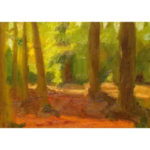Why I Love Copying

Isn’t it a shame that more people don’t see why I love copying? It’s true! Copying another person’s painting may seem downright wrong. Don’t you think? But wait, before I elaborate, I will share this blog and post’s purpose and welcome new reader’s too!
Small Spaces Special Places
Welcome new readers! Each year, I select a theme for my weekly paintings. This year’s is “Small Spaces Special Places.” Why? I have been surprised, even delighted, with the small spaces in our house that have captured my eye.
Also, there are the special places I see on my daily dog walks. Each morning, rain or shine, I love getting outdoors and looking for things to paint. Sometimes, we venture on the road and I share paintings of special places from these trips, too.
If you or someone you know will enjoy a weekly dose of color, sign up here for this weekly blog. Let’s get to this week’s topic of – gasp – copying!
This week’s Master to copy
A couple of week’s ago, I wrote about a landscape painter I had never heard of named Willem Bastiaan Tholen. This week, the adoration continues. Why? I am smitten with the way this painter breaks rules. What rules you may ask? Nothing naughty or nefarious, just painting composition rules.
This all started when I decided to study and share information about composition, one tip a day Monday through Friday, for 100 days starting in May of this year via Instagram. There are so many rules and recommendations in composition. And, I thought it would be fun, even educational, to study this topic and share it. I also am sharing composition tips for collectors although not as frequently as tips for artists.
Enter copying someone else’s painting! As a painter, I want to absorb as much information about this topic as possible. And, what better way to do that then to paint someone else’s painting. Right?
Part of the Why
So there’s part or a start of the reason why I love to copy paintings. I get to look at beautiful paintings throughout history. Then when I see one that takes my breath away, copy it. This, to me, is such a better way to study art history then the slide show lectures I sat through…er…snoozed through in college. (Shhh don’t tell anyone). Ha!
But that’s not the end game. Ultimately, I am seeking to find the underpinnings or structure of wonderful paintings others have done so that I can do my own. To clarify, I mean I paint my own original painting using what I have learned from the paintings I have copied.
Why Tholen
You may wonder why Tholen? Part of this answer is subjective: I love his paintings! But, in the time that I have been sharing tips on Composition, I have noticed something unique about Tholen. He loves breaking composition rules. For instance, there’s a composition rule that a painter ought never place a straight line near the edge of a painting. Ever!
Check out this painting by Tholen and his overt breaking of that rule in a beautiful way.

Do you see how he gets our eyes to move throughout the composition? And, he breaks another rule by having the horizon line practically smack dab in the middle of the painting. But the subtle clouds lure your eye up. Then you can follow the edge of the tree next to the right hand column. My eye follows that to the water, then to the trees in the near distance. Does your eye do that too?
Another Tholen Master Painting
Here’s another painting by Tholen where he commits the same crime. See those trees? They are so close to the edge. In fact, the tree on the left is partially cut off of the canvas.

But this painting is so alluring and just feels as if we (the viewer) are experiencing a moment in the interior of a lovely forest. I studied this painting by doing several Notan studies. Recall that Notan studies are a shape and pattern defining tool. And, there is something constructive about taking a look at a painting at it’s most fundamental level: in black and white.
You don’t have to do this with pen or pencil and paper. Rather, you can take a photo of your favorite painting and then use the ‘convert to black and white’ option in the camera on your phone. This is the ‘easy button’ version of doing Notan. But even looking at the black and white values of a painting helps to simplify and see where your eye goes in the painting, if anywhere.
Next Steps
I can see copying the compositions of other paintings in history as a long term learning tool. In fact, I have started off the past few weeks doing just that. The challenge is creating effective, rule-breaking compositions of my own. And, since it always helps to have a Plan B in place, I will continue to create paintings using the composition rules I am learning and sharing along the way. In fact, I foresee this as a sensible plan going forward. Why? Well, there’s such value in getting total clarity and understanding of the rules. Then, breaking them. Don’t you think?
What Rules Do You Break
What about you, gentle reader, are there rules that you have learned and now break with style and panache? If so, please do share in the comments below and thank you for reading today!

5 Comments
Alexandra
June 10, 2021Lovely post, Julie! I especially love the painting you created based on the Tholen painting set in the forest. It’s so luminescent! Great choice of colors.
Your method of copying is so wise and instructive. (Who are these people who don’t see why you don’t love copying??) In college, I copied a Matisse painting and then created a painting based on his style. Just like you’re doing! It really helped loosen me up. It was also a relief to just follow someone else’s guides for awhile without having to come up with my own.
With regard to breaking rules, I think I do it everyday by living a life that is diametrically opposed to the one that was presented to me in my formative years; and I am so much happier for it!
Julie Holmes
June 13, 2021Hi Alexandra,
Thanks so much! It’s instructive to know that you, too, have copied Masters. I find there are many contemporary artists who actually seek out compositional elements of Master Paintings to inform their own. The thinking being that if that composition has worked once, even hundreds of years ago, it certainly can work again with a contemporary and personal approach.
And, YES, I would agree your life is on a path that is so wonderfully and uniquely your own. And, I’m so glad to count you as a friend as you follow your rule breaking and creative path!
Onward! Right?
Alexandra
June 15, 2021Yes! Definitely onward and upward. I feel lucky to call you friend! xoxoxoxoxo
Beth Dyer Clary
June 11, 2021I actually prefer the colors in YOUR copy! There is a brightness that is lacking in Tholen’s. Maybe that doesn’t matter but if I’m going to stare at a painting of a sun-dappled forest, I prefer yours!
I’m surprised you’re getting any grief for breaking rules too! We’re in a strange time when “law and order” seems important to some and busting myths/roles, etc is defining to others.
Not much of a rule-breaker myself, at least not consciously. But the few times I have in the relatively recent past, the pay off has been huge in some way. Takes courage to step outside the rules. I find your persistence in this inspiring. Keep going please!
Julie Holmes
June 13, 2021Hi Beth,
Thank you! I think we have so many more options and choices for oil colors than artist did even 100 years ago. So, that’s one reason why Tholen’s painting may be subdued.
Well I confess I am not much of a rule breaker myself. That strict but loving upbringing, I guess? Am glad you are figuring out a way to navigate beyond the rules in a way that’s strengthened you. Roar and right on, Beth!
Thank you for the encouragement about persistence. I’ll do what I can to carry on! Thanks so much, Beth!